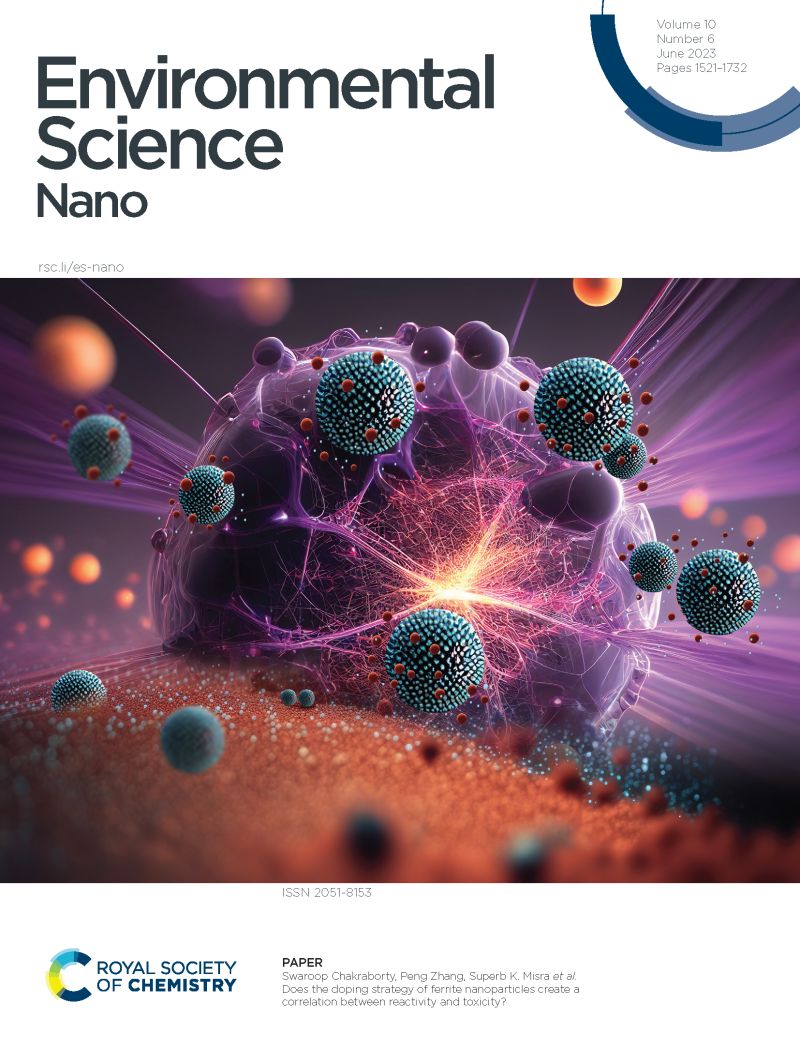Construction of clay-mediated nZVI composites to alleviate the decline in Cr(VI) removal during co-transport with humic acid and phosphate
IF 5.8
2区 环境科学与生态学
Q1 CHEMISTRY, MULTIDISCIPLINARY
引用次数: 0
Abstract
The natural presence of phosphate and humic acid (HA) may impact the removal of Cr(VI) by green synthesized clay-supported nano-zero-valent iron (nZVI@GT) composites. It triggers the investigation of Cr speciation transformation by M-nZVI@GT and K-nZVI@GT, prepared through nZVI@GT loaded on montmorillonite and kaolinite clays. The Cr(VI) removal with the existence of phosphate and HA was investigated during cotransport in water-saturated sand columns. This study revealed that M-nZVI@GT exhibited a higher Cr(VI) removal capacity (82.08 mg·g⁻¹) than K-nZVI@GT (61.74 mg·g⁻¹). However, phosphate showed stronger competition with Cr(VI) for adsorption on the single-layer structured M-nZVI@GT, reducing its removal capacity to 61.98 mg·g⁻¹ and inhibiting Fe0 core corrosion compared to the lamellar-structured K-nZVI@GT. Notably, phosphate enhanced the electrostatic repulsion between M-nZVI@GT and quartz sand, facilitating the mobility of M-nZVI@GT in the sand porous media (increasing from 41.03% to 52.20%). This enhancement was associated with a higher k1d/k1 value, which increased from 0.691 to 0.830. In particular, due to its steric hindrance of macromolecular, less HA entered the lamellar structure of K-nZVI@GT, lowering competitive adsorption with Cr(VI) for active sites. This research’s findings indicate that the K-nZVI@GT, as an environmental-friendly remediation material, can successfully alleviate the inhibitory effects of HA on Cr(VI) removal in contaminated soil. This study highlights the distinct structural construction of Fe-based nanomaterials via different clay meditations to improve the practical application of nanotechnology for soil in-situ remediation.构建粘土介导的nZVI复合材料以缓解与腐植酸和磷酸盐共运输过程中Cr(VI)去除率的下降
磷酸盐和腐植酸(HA)的天然存在可能会影响绿色合成的粘土负载纳米零价铁(nZVI@GT)复合材料对Cr(VI)的去除。通过在蒙脱土和高岭石粘土上加载nZVI@GT制备的M-nZVI@GT和K-nZVI@GT,引发了Cr形态转化的研究。研究了含磷酸盐和HA的饱和砂柱在共输运过程中对Cr(VI)的去除。该研究显示M-nZVI@GT比K-nZVI@GT (61.74 mg·g⁻¹)具有更高的Cr(VI)清除能力(82.08 mg·g⁻¹)。然而,与层状结构K-nZVI@GT相比,磷酸盐与Cr(VI)在单层结构M-nZVI@GT上的吸附表现出更强的竞争,使其去除能力降低到61.98 mg·g⁻¹,并抑制了Fe0核心的腐蚀。值得注意的是,磷酸盐增强了M-nZVI@GT与石英砂之间的静电斥力,促进了M-nZVI@GT在砂多孔介质中的迁移率(从41.03%增加到52.20%)。这种增强与较高的k1d/k1值相关,k1d/k1值从0.691增加到0.830。特别是,由于其大分子的位阻作用,较少的HA进入K-nZVI@GT的片层结构,降低了与Cr(VI)对活性位点的竞争吸附。本研究结果表明K-nZVI@GT作为一种环境友好型修复材料,可以成功缓解HA对污染土壤中Cr(VI)去除的抑制作用。本研究强调了铁基纳米材料通过不同的粘土冥想形成不同的结构结构,以提高纳米技术在土壤原位修复中的实际应用。
本文章由计算机程序翻译,如有差异,请以英文原文为准。
求助全文
约1分钟内获得全文
求助全文
来源期刊

Environmental Science: Nano
CHEMISTRY, MULTIDISCIPLINARY-ENVIRONMENTAL SCIENCES
CiteScore
12.20
自引率
5.50%
发文量
290
审稿时长
2.1 months
期刊介绍:
Environmental Science: Nano serves as a comprehensive and high-impact peer-reviewed source of information on the design and demonstration of engineered nanomaterials for environment-based applications. It also covers the interactions between engineered, natural, and incidental nanomaterials with biological and environmental systems. This scope includes, but is not limited to, the following topic areas:
Novel nanomaterial-based applications for water, air, soil, food, and energy sustainability
Nanomaterial interactions with biological systems and nanotoxicology
Environmental fate, reactivity, and transformations of nanoscale materials
Nanoscale processes in the environment
Sustainable nanotechnology including rational nanomaterial design, life cycle assessment, risk/benefit analysis
 求助内容:
求助内容: 应助结果提醒方式:
应助结果提醒方式:


